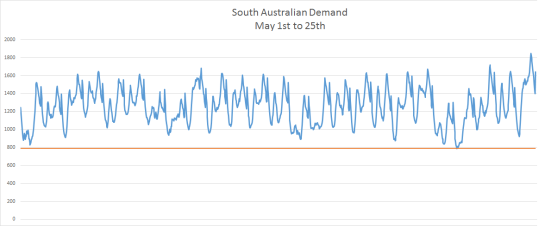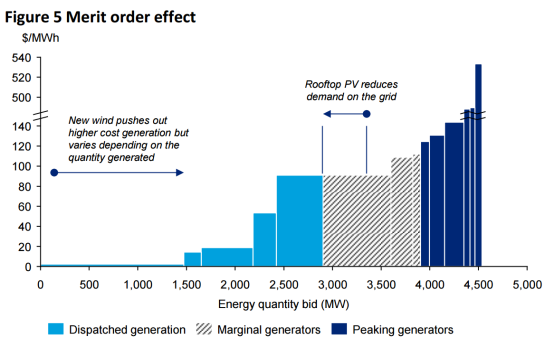“Renewables will replace the old ‘base load and peak load’ power systems.”
The Northern and Playford brown coal-fired power stations at Port Augusta once provided most of South Australia’s electricity. Their age and inexpensive fuel established them as the state’s baseload for decades. May 9th saw the end of generation at the remaining Northern units. Does this mean that South Australia’s wind and solar capacity can now take their place?
Firstly, what is baseload? Here is the South Australian electricity demand curve for the first three weeks of May.

The morning, evening and hot water service demand peaks, as well as reduced weekend demand are shown by the blue curve, in megawatts. The baseline is indicated in red.
Another term for demand is load. Thus, below the peaks and the troughs of daily demand is the base of the load. In practice, the baseload of the demand curve exists well below the line in the image, and in a conventional electricity market is served by 24/7, low operational cost generators – below higher marginal cost, flexible intermediate generators. In other words, some power stations are most economical to operate continuously, while others are better at increasing and decreasing their output due to savings in fuel, operating costs, etc. From this emerges a merit order for a given market’s generators.

This figure, from Deloitte’s 2015 analysis of SA’s renewable energy challenges, shows baseload capacity as the shortest light blue rectangles.
This chart is from Aneroid Energy and shows the days that Northern’s units ceased operation. Following the 9th, the Osborne combined cycle gas plant at Outer Harbour was brought online.
This power station is operated by ATCO and supplies to Origin Energy under a power purchase agreement. As can be seen above, it appears to have somewhat assumed the mantle of South Australia’s baseload generator.
Sunday was a day of extreme wind conditions, low demand and low wholesale prices, accounting for the temporary shutdown of Osborne. Notably, Torrens Island power station continued operation throughout, supplying indispensable frequency control and ancillary services – the signal and inertia which makes our alternating current electrical supply work (see pages 12 and 13 of the Deloitte report). The state’s wind fleet cannot supply these services.

Osborne CCGT output (pink) and one of Torrens Island’s gas boiler units output (red). Note the most recent Sunday.
The flexibility displayed by Osborne is also reminiscent of Northern’s past operation.
Perhaps the most overlooked aspect of the dynamic between baseload, flexible and renewable generators is the Large-scale Generating Certificates which technology such as wind is entitled to sell. This currently amounts to more than $80 per MWh. Though unjustifiable under any Renewable Energy Target, equivalent compensation to a power station like Osborne would undoubtedly result in constant baseload output.
Verdict:
South Australia’s wind and solar capacity are obviously and fundamentally different to on-demand scheduled generators, and do not supply the base of the load. Furthermore, their position in the market merit order is a product of government support.
The state can boast considerable emissions reductions in the electricity sector as a result of its wind capacity, and the conventional role of baseload is now certainly of limited usefulness. But applying it to renewables only confuses the ongoing challenges, and should really be avoided in responsible commentary.



According to the AEMO homepage the spot price of piped gas in SA is $7.88 per GJ or double the traditional price of $4. What’s left of Cooper Basin gas is going to Korea etc via Qld as LNG. Combined cycle baseload will be expensive so there will be steady demand for Vic coal power imports. That is more CO2 intensive than Northern, the interconnector could fail lke Basslink (still under repair) and Vic baseload closures could raise the price. Note that the 1600 MW Hazelwood brown coal plant is up for sale or closure.
I see predictions that the LGC will hit $90 per Mwh. Every day is Xmas for the coddled wind generators. SA needs its own non-carbon baseload generator. I think a CANDU is about the right size and it could also re-fission spent fuel from east coast light water plants.